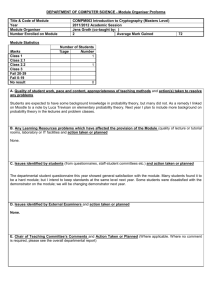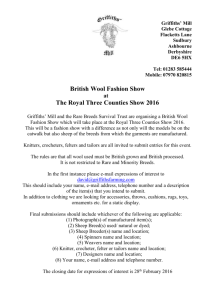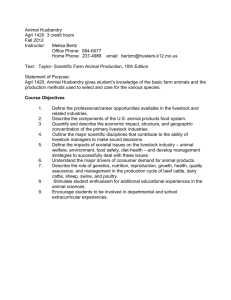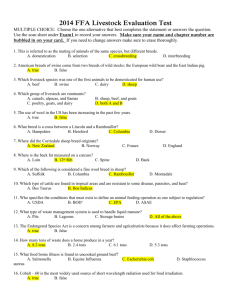Junior Certificate Business Studies
advertisement
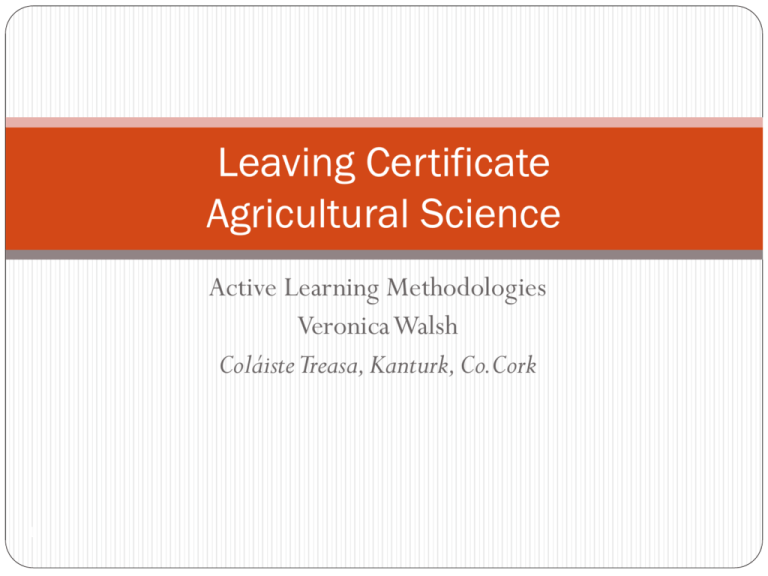
Leaving Certificate Agricultural Science Active Learning Methodologies Veronica Walsh Coláiste Treasa, Kanturk, Co.Cork 1 Overview Active learning The learning pyramid Reasons for using active learning Active learning strategies The teachers role in active learning Tips for teachers 2 Active Learning An important learning principle, supported by extensive research is that students learn best when they are actively involved in the learning process This is illustrated using the learning pyramid The further down the pyramid students go, the more information they learn and retain 3 Source: National Teaching Laboratory Institute 4 Why use active learning? Behind every good teacher is an exhausted class! “Tell me, I forget. Show me, I remember. Involve me, I understand.” Chinese Proverb “Give a man a fish; you have fed him for today. Teach a man to fish; and you have fed him for a lifetime.” Author unknown 5 Business and industry have clearly advocated that in today’s education system, there must be a place for teaching students to become team members, to share resources and talents, and to acquire social skills that will help them in the workplace. Texas Higher Education Co-ordinating Board “What children can do together today they can do alone tomorrow.” Vygotsky, 1965 Experience + Reflection = Learning 6 “What is the most effective method of teaching? Students teaching other students.” McKeachie, Pintrich, Lin, & Smith, 1986 When students were asked to discuss with a partner what a teacher presented at frequent intervals during the class, they received up to two letter grades higher than students in the control group did Ruhl, Hughes, and Schloss, 1977 7 Whoever explains, learns 8 David Sousa Active Learning Strategies Group projects Paired Reading Role playing Drill and Review Pairs Research Turn-to-your-neighbour summaries Table quizzes Four-step review Crosswords Matching exercises Word-search Whip-around Mind-maps Graphic Organisers Think-Pair-Share 9 Ideal topics for group projects Experiments Genetics Animal Identification Plant identification Mind mapping of any topic The environment and agriculture Grassland Management Cultivation Machinery 10 Group-work The size of the group will depend on a number of factors – TEAM T – time E – experience A – age M – materials 11 Other factors to consider Give only one copy of materials per group This ensures that group-members need to work together in order to complete the task Inter-group competition This can create a sense of competitiveness between groups within the class to see who learned the material best 12 Assigning groups Random assignment Teacher selected Self-selected groups 13 Role Playing Suitable topics include: The consumer – conflict with the retailer The person at work Industrial relations Resolving a dispute Interviewing potential staff Holding a meeting (clubs) Deciding what to do with a budget surplus/deficit 14 Research Take students to computer room to conduct web searches on curriculum topics, using a worksheet to focus their search Consumers Association of Ireland http://www.consumerassociation.ie National Consumer Agency http://www.consumerconnect.ie Central Statistics Office http://www.cso.ie Advertising Standards Authority of Ireland http://www.asai.ie General learning resources http://www.skoool.ie http://www.scoilnet.ie http://www.teachnet.ie 15 Table Quizzes Can be conducted at the end of any topic Split class into groups (of 3, 4 or 5) The team with the highest score wins Try to ensure each group has at least one strong member Students learn from each other, and have a greater sense of achievement than when working alone 16 Crosswords Can be used individually, in pairs or in small groups Easily created using resources on the internet Ideal project for Transition Year students Suitable for all topics on the Agricultural Science Syllabus. 17 Word Searches Suitable for individual and paired use When complete, students should write the definition of the word, and give an example if appropriate on the back of the sheet, or in their copy Easily created on the internet 18 Mind-Map At the end of a topic, create a mind-map of the topic to assist revision Initially this can be done on the board or overhead projector Students can re-do this at home, using colour and their own creativity Software available, both free and paid www.mindmeister.com FREE 19 Mind-Map 20 Think-Pair-Share A strategy for answering possible test or exam questions Students individually think of their answer, perhaps writing down their main points They pair up with a partner They discuss their answer with their partner, and come up with a new, improved answer, taking the best from each They share their results with the class 21 Paired Reading Turn headings into questions Read bite-sized chunks silently Prioritise important points with a partner Summarise and write down the important points Continue through the material Decide on the most important points, devise questions to check comprehension Create a visual 22 Drill-Review Pairs Students drill each other over material until they are certain that each other knows and can remember all material Used for test review Teacher checks understanding as needed When the pair have finished, they should check their answers with another pair 23 Turn-to-your-Neighbour Summaries Common practice: ask one student for a summary of what they learned Problem: only that student is active; the others are passive Solution: turn-to-your-neighbour summaries Resource required: worksheet to review material covered in class 24 Students in turn should summarise what they have learned so far They should turn to their neighbour and share their answers and reasoning Students should listen carefully to their partner’s explanation They should create a new, joint answer that is superior to their initial individual work Both members should agree on this answer and be able to explain it The teacher can randomly select students to explain the joint answer they created with their partner 25 Four-step review Useful for correction of homework or tests Also good for review of a new topic Method: 1. 2. 3. 4. 26 Students write the answer individually The group members answer together The teacher gives the answers Groups check how they did and re-teach each other Matching Exercises Match the definitions on the left with explanations on the right Used in exam situations Can be created on the internet, by teacher or by Transition Year students 27 Whip Around A method for reviewing material at the end of a class or a topic Students sit in a group of 3 or 4 Taking turns, students have to say one thing that they have learned during the class or the topic Continue until they run out of topics Listening to what others have learned can reinforce what the student themselves has learned 28 Teacher’s Role In active learning, the teacher moves from being the “sage on the stage” to the “guide on the side” Teaching methods are student-centred, and should move away from using lecturing, individual reading assigments and isolated work Teachers become coaches, guides, sources of information, experience and encouragement 29 Tips: Use short segments of time e.g. “you have three minutes to complete the first two questions” Keep group size small. It takes a lot of skill to manage a group of 4 or more. Group size of 2 or 3 is best Don’t let students choose their own groups. The temptation to go “off task” is too great Carefully monitor groups while they are working Only distribute one resource per group, which encourages positive interdependence 30 When we work in groups we: G – give encouragement R – respect one another O – stay on task U – use quiet voices P – participate actively S – stay in our group 31 Graphic Organisers Provide a visual method of organising and summarising information Provide a high quality teaching and learning methodology for mixed ability classrooms Accommodate the needs of students with different learning styles or intelligences May be used for: Pre-teaching/introduce a topic Teaching a topic Assessment for learning Studying Revision of a topic 32 Graphic Organisers Agricultural Science Ranking Ladder Used to prioritise of rank ideas / information © 2008 Steps in an Experiment Conclusion Results Control method Equipment Title Start here Step Ladder When a topic involves prioritising or establishing stages with a definite beginning and end Examples: Steps in podzolisation 36 Stair Steps Used for topics involving a step by step process / plotting a course of action © 2008 Stair Steps Can be used when a topic involves a step-by-step process Examples: Bog Formation Embryo Transplanation 38 Scientific Method- An Organised approach to solving problems. Principle- arises from a theory which is always true. Limitations of S.M. •Extent of our Basic Knowledge. •Ability to interpret results •Accidental Discovery •Application to the natural world in a state of change Theory- is an explanation based on repeated hypothesis & experimentation. Tests Hypothesis. Directly/ Indirectly Interpretation Result Experimentation Observation Ethics refers to whether issues are right or wrong Hypothesis •Control- provides a standard Educated guess based on hypothesis •Careful Planning & Design Collected and Recorded & Published – Magazines, etc. •Safe. •Repeatable/Replicates •Fair- sample size •Random Selection. •Double Blind Testing Placebo Results are analysed. Conclusion A conclusion is drawn in the context of existing knowledge. Other possible uses Formation of blanket Peats Formation of basin Peats Stages in Silage Making Stages in Sexual Reproduction in a flowering Plant © 2008 Sequence Chart When topic involves a sequence of events Project Guidelines Plan Topic Housing Disease Control Take Photos Husbandry Put all sections together Breeds Types of Enterprise Submit Project Other possible uses Anything with a definite sequence of events Chain of Events When topic involves a series of interlinked events © 2008 Stages in Lifecycle of Liverfluke Adult Fluke in Primary host. Funnel When synthesising ideas, drawing conclusions, reducing a body of information to its core e.g. creating a definition © 2008 Mineral Matter In soils Sand Silt Clay Gravel Mineral Matter Other possible uses Any definition Composition of soil Composition of colostrum Composition of milk Fish Bone 49 Cereals Fertiliser & Harvesting Seed bed Prep Soils & Climate pH 6.5 Plough Deep well drained Harrow NPK Sandy Loam Moisture during Soil Tests Roll- spring only Growth Combine harvester July/ Aug 5-8 ton/ha 3 ton Straw GRAMINEAE Yield and Family Barley Winter- 1 st Oct Tolerant to continuous Spring- 1st Mar. Sowing Combine drill 1 in 3 ideal Sowing & Establishment Crop Rotation Fish Bone Useful for summarising a whole topic in one space Students often find summarised in this way is easier to remember than pages of text Helps to organise and structure information 52 Other possible uses Beef Pigs Sheep Dairy Beet/Potatoes Brain Droplets For idea generation © 2008 Trace Dissolved in salt Cu Zn Fe Na Mg Ca Oxygen Hydrogen Nitrogen Phosphorus Most Common Sulphur Elements in Food Other possible uses Calf to beef system © 2008 Cross Classification Chart When condensing and organising comparative data according to various criteria Cross Classification Chart Useful for organising information according to various criteria Can be used to summarise information in a way that is easy to remember Uses: Food Tests 58 Tillage Soils & Climate Cereal Potatoes Beet Crop Rotation Varieties Seed Bed Prep & Harvesting Sowing Storage Establish Yield ment. Disease Control Double Venn Diagram Title Title Different Different Similar When examining the similarities and differences between two items Mitosis V Meiosis Mitosis Meiosis Different Different Similar Venn Diagram Effective for examining the similarities and differences between two items Examples: Osmosis V Diffusion Performance V Progeny Testing Condition Scoring V Conformation Photosynthesis V Respiration Colostrum V Milk Atmospheric Air V Soil Air Compare dairy breeds to beef Breeds 62 Triple Venn Diagram © 2008 © 2008 Four Corner Organiser When two criteria of four related topics or concepts are being explored Four Corner Organiser Useful when characteristics of four related concepts/topics/people are being explored Place the four in the centre of the organiser and two criteria on the outside Examples: 65 Rights and responsibilities of stakeholders Community development partners Financial institutions Marketing mix Types of Nutrition omolecules Triglyceride Phospholipid FA 1 Glycerol MonosaccharideGlucose DisaccharideSucrose/Maltose Energy release, produces energy, cell walls FA 2 Glycerol FA1 FA 3 PolysaccharideStarch/gylcogen/fibre Carbohydrates Carbon Hydrogen Oxygen Fats Energy release, insulates, energy store FA 2 P Animals Plants Ca- Bones & teeth Ca- forms middle Lamella Fe- forms Haemoglobin Mg- Forms Chlorophyll Minerals Carbon Hydrogen Oxygen Vitamins Proteins Amino Acid Growth & repair of cellsMyosin, Keratin Hormones, Antibodies, enzymes Water 1. 2. 3. 4. 5. Excellent Solvent Component of body fluids. Bulk of cytoplasm Good absorber of heat Medium for Chemical Reactions Water SolubleVitamin C•Forms connective tissue especially skin & Muscles. •Deficiency Disease- Scurvy •Helps Healing •Immune System Fat Soluble – Vitamin D •Helps absorb calcium •Healthy bones & teeth •Deficiency DiseaseRickets/ osteomalacia •Source= Sun Other possible uses Grassland Management Systems Genetics Definitions Tri Pie This can be used to generate ideas for different points of view Con Pro Maybe © 2008 Starburst This is used when establishing five points in answer to a question © 2008 Starburst (all points covered) Many examination questions require five points in the answer This organiser helps students who are visual learners to remember the points easily Agreeing the points in a small group helps long-term memory retention Examples: 71 Characteristics of LifeERRON Continuity of Metabolism is the sum of all the chemical reactions that take place in the body Excretion The process of getting rid of waste products of metabolism. life. Where living organisms arise from other living organisms Nutrition Reproduction Characteristics Of Life The process by which an organism obtains and uses food from its environment The ordered way in which living organisms are arranged anatomically and socially. Cells The production of new individuals. Life comes from life. Organisation Tissues Organs Response Systems Organism Is how organisms react to stimuli in their environment. Other possible uses Factors that affect FCR Factors that affect Soil formation Signs of animal Health Breeds of animals- Dairy, Pigs, Sheep, Beef, Poultry. Methods of Heat detection. Soils Types- Podzols, Brown Earths, Gleys, Blanket peat, Basin Peats. Elements and their functions © 2008 Research Grid This is a question and answer learning methodology Note: additional cells may be added as required Research Grid Question and answer learning methodology Questions are written by the teacher and students research the answers and write them in One organiser can be shared by a group and students can then fill in their own organiser for homework and keep it for study and reflection Examples: 75 Sheep What is a flushing? Insert answer here What is breeding out of season? Insert answer here Explain Conformation Insert answer here What is sponging? Insert answer here Name 2 lowland sheep breeds and 2 Mountain breeds Insert answer here Explain Condition Scoring Insert answer here Other possible uses Preteaching most topics to find what students already know Revising any topic



